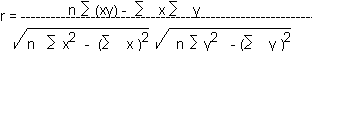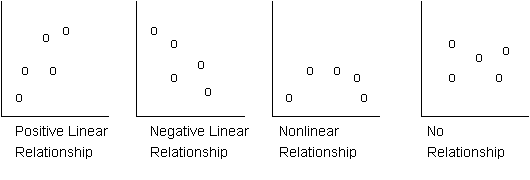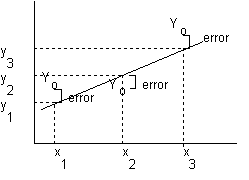
If you take the above actions you should get the sum of the x column as 161, the sum of the y column as 4.895, the sum of the x2 column as 3731, the sum of the y2 column as 4.1190 and finally the sum of the x times y column as 116.865. If you use these numbers in the correlation coefficient equation given above you should get a value of r (the correlation coefficient) of 0.9695. As the absolute value of r is very close to 1 this indicates a strong correlation between the two variables. Remember r is between -1 (perfect negative correlation) and +1 (perfect positive correlation), with 0 indicating no correlation.
Our last step will be to use the data to calculate a linear equation (regression equation) that allows us to predict values of cost if we are given values of speed. The general form of our equation is Cp = mS + b Where Cp stands for predicted cost, S stands for speed, m is the slope of our line and b is its y axis intercept. The figure shown below provides the formulas for the necessary calculations.

Using the data given in the table (above) the calculated value of the slope, m, is 0.1529 (rounded to four places) and the value of b is -2.8164 (also rounded to four places). The equation is y = 0.1529x - 2.8164. If we wanted to have a predicted value for a speed of 22.5 knots we would use x=22.5 in the equation: y = 0.1529(25) - 2.8164 = 0.6239 million pounds sterling. As you can see from the data this is somewhat above the actual value of between 0.470 and 0.575 (million pounds sterling). In another section we will fit other functions to this data to see if we can improve the estimates. Note that if we had tried to estimate the cost of a 50 knot ship (not possible at that time) our equation would have given us a number even if it was not possible to build such a vessel at that time. The lesson here is that you need to be careful when you predict outside the domain of values already observed.
Practice Problem 1 - Linear Regression - Using the data in the table shown below calculate the regression coefficient, r and the equation of the regression line y = bo + b1x.
Answer to the practice problem.
All of the values needed to calculate r and the regression equation are calculated in the table shown below.
| x | y | x2 | y2 | xy |
| 0.00 | 1.50 | 0.00 | 2.25 | 0.00 |
| 1.00 | 2.50 | 1.00 | 6.25 | 2.50 |
| 2.00 | 5.5 | 4.00 | 30.25 | 11.00 |
| 3 | 6.5 | 9.00 | 42.25 | 19.50 |
| --- | --- | --- | --- | --- |
| 6.00 | 16.00 | 14.00 | 81.00 | 33.00 |






